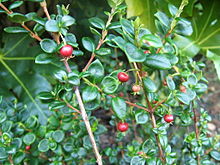Ugni
Ugni is a genus of plants of the myrtle family (Myrtaceae). Four species belong to this genus, all from western America.
| Ugni | |
|---|---|

| |
| Ugni molinae | |
| Scientific classification | |
| Kingdom: | Plantae |
| Clade: | Tracheophytes |
| Clade: | Angiosperms |
| Clade: | Eudicots |
| Clade: | Rosids |
| Order: | Myrtales |
| Family: | Myrtaceae |
| Subfamily: | Myrtoideae |
| Tribe: | Myrteae |
| Genus: | Ugni Turcz. |
| Type species | |
| Ugni molinae | |
Description
changeThey are small evergreen shrubs. The leaves are simple, entire, opposite, elliptical; they are 1–2 cm long and 0.2-2.5 cm broad, dark green, and with a spicy scent if broken into many small pieces.[1]
The solitary flowers are usually hanging; they are 1–2 cm diameter with four or five white or pale pink petals and many short stamens. The fruit is a small red or purple berry, 1 cm in diameter, with many seeds.[1]
Name
changeThe name comes from Uñi with which the Mapuches (native people from south-central Chile and southwestern Argentina) name the fruits of the best known species of the genus, Ugni molinae.
The genus was formerly often included in either Myrtus or Eugenia; it is distinguished from these two genera by the hanging flowers with stamens shorter than the petals.
The Russian botanist Nicolai Stepanowitsch Turczaninow created the genus Ugni in 1849.[2]
Where it grows
changeAll species of this genus are found in western South and Central America, native from southern Mexico to central southern Chile and Argentina.
Species
changeThere are four species in this genus:'[3][4]
- Ugni candollei (Barnéoud) O.Berg: Chile
- Ugni molinaeTurcz.: Chile and Argentina
- Ugni myricoides (Kunth) O.Berg: Southern Mexico, Central America to Bolivia, Venezuela and northern Brazil
- Ugni selkirkii (Hook. & Arn.) O.Berg: Endemic species of the Juan Fernández Islands, Chile
Uses
changeUgni molinae is grown as an ornamental plant and for its edible fruits; these fruits are also used to make jams.[5]
References
change- ↑ 1.0 1.1 Carmen Ulloa Ulloa & Peter Møller Jørgensen. "Ugni Turcz". Árboles y arbustos de los Andes del Ecuador (in Spanish). eFloras.org. Retrieved 24 July 2013.
- ↑ Nicolai Stepanowitsch Turczaninow (1848). "Bulletin de la Société impériale des naturalistes de Moscou, xxi, No. 1" (in Latin). p. 579. Retrieved 24 July 2013.
- ↑ Royal Botanic Gardens, Kew. "Ugni". World Checklist of Selected Plant Families. Retrieved 24 July 2013.
- ↑ "Search results - Ugni". The Plant List. Retrieved 24 July 2013.
- ↑ "Lost Crops of the Incas:". The National Academies Press. Retrieved 24 July 2013.